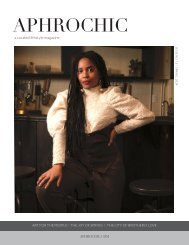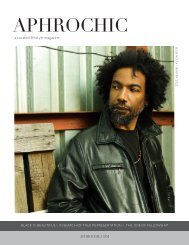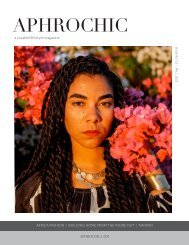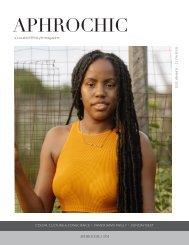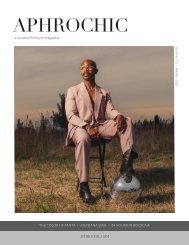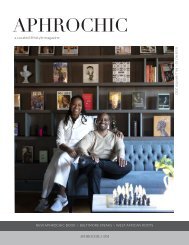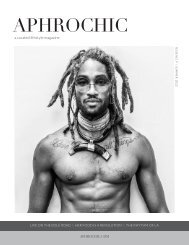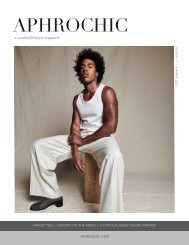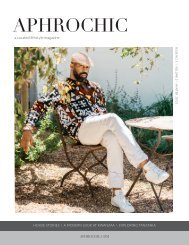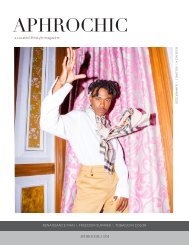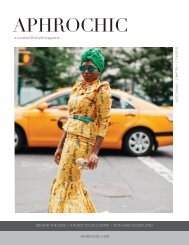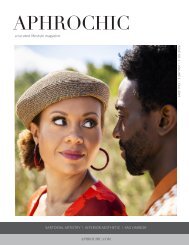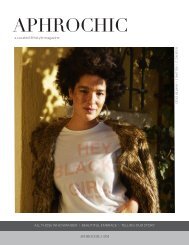AphroChic Magazine: Issue No. 8
This issue is about revolution, remembrance, and rebirth. In Dubai, Chef Alexander Smalls is launching a first-of-its-kind food experience celebrating the culinary revolution taking place in Africa. In New York, as fashion week returned, House of Aama launched a collection remembering the elegance of 20th century Black resort towns. In Philadelphia, Chanae Richards is carving out space for rest, relaxation and meditation. And in Los Angeles, our cover star, Jennah Bell, is part of a renaissance of music that is indie, soulful and written from the heart. In this issue we take you to The Deacon hotel designed by Shannon Maldonado. And in our Wellness section, we let you in our own road to rebirth, through the journey with long-haul COVID that has defined our life this past year. In our Reference section we explore new thoughts on the African Diaspora. Looking beyond the history behind the word to explore the idea itself, opening new worlds of possibility as we begin working to understand what the African Diaspora actually is. And we take you inside the importance of the emerging Black art scene heralded by the Obama portraits which, now well into their national tour, made a memorable stop at the Brooklyn Museum.
This issue is about revolution, remembrance, and rebirth. In Dubai, Chef Alexander Smalls is launching a first-of-its-kind food experience celebrating the culinary revolution taking place in Africa. In New York, as fashion week returned, House of Aama launched a collection remembering the elegance of 20th century Black resort towns. In Philadelphia, Chanae Richards is carving out space for rest, relaxation and meditation. And in Los Angeles, our cover star, Jennah Bell, is part of a renaissance of music that is indie, soulful and written from the heart.
In this issue we take you to The Deacon hotel designed by Shannon Maldonado. And in our Wellness section, we let you in our own road to rebirth, through the journey with long-haul COVID that has defined our life this past year.
In our Reference section we explore new thoughts on the African Diaspora. Looking beyond the history behind the word to explore the idea itself, opening new worlds of possibility as we begin working to understand what the African Diaspora actually is. And we take you inside the importance of the emerging Black art scene heralded by the Obama portraits which, now well into their national tour, made a memorable stop at the Brooklyn Museum.
Create successful ePaper yourself
Turn your PDF publications into a flip-book with our unique Google optimized e-Paper software.
HOT TOPIC<br />
will be part of a visual record that will last<br />
long after his terms in office have faded<br />
into antiquity. As such, it will be one of the<br />
most lasting and personal statements on his<br />
presidency. For a president with an eye on<br />
history and a deep connection to contemporary<br />
art and culture, Kehinde Wiley was a<br />
clear choice.<br />
Like Amy Sherald, Kehinde Wiley<br />
is known for monumental works that<br />
challenge mainstream notions of race,<br />
culture and power. For Wiley, his habit of<br />
“street casting” people met by chance on the<br />
street to model for him speaks directly to his<br />
method of reinterpreting famous works of<br />
European portraiture to spotlight contemporary<br />
Black people. But Barack Obama was<br />
no chance meeting, and the difference was<br />
apparent to Wiley from the start. “Generally<br />
I’m painting the powerless,” Wiley says in<br />
a video interview available in the exhibit,<br />
noting by contrast that having the American<br />
President as your model means working<br />
with “arguably, the most powerful man in<br />
the world.” But for President Obama, that<br />
reversal was exactly the point. “I was always<br />
struck by the degree to which [Wiley’s<br />
portraits] challenged our conventional<br />
views of power and privilege,” Obama<br />
is quoted in the exhibit. The President<br />
lauds the artist’s “extraordinary care and<br />
precision and vision in recognizing the<br />
beauty and the grace and the dignity of<br />
people who are so often invisible…”<br />
Over the course of a year through a<br />
combination of photo shoots and in-person<br />
sittings, Wiley and Sherald completed their<br />
respective works, which were unveiled to<br />
the world in 2018. Seen individually, they<br />
are masterful works befitting the Obamas<br />
stature as both political figures and cultural<br />
icons. Taken together, it’s striking how very<br />
different the two images are.<br />
A Study in Distinction<br />
The portrait of Barack Obama explodes<br />
with color. From the billowing, floral<br />
backdrop to the tone of the president’s<br />
skin, everything in the image is vibrant and<br />
lively. Far from the formal stances that most<br />
presidents have adopted in their portraits,<br />
Obama in this image is conscientiously<br />
informal, with an unbuttoned shirt, no tie<br />
and absent any of the background regalia<br />
associated with his office. Rather than<br />
standing imperiously or sitting regally, the<br />
president is leaning forward as if engaged<br />
in conversation. His gaze is direct, and in<br />
that somewhat unsettling way that he often<br />
does, Kehinde Wiley succeeds in creating<br />
the lifelike impression that the man in this<br />
painting is very interested in what you’re<br />
about to say. In all, it’s a very colorful and<br />
engaging look at a person whose position<br />
typically sets them apart.<br />
Amy Sherald’s portrait of Michele<br />
Obama is an equally masterful work made<br />
all the more striking by its deep contrasts<br />
with Wiley’s portrait of Barack. Featuring<br />
Sherald’s typically subdued color palette<br />
and minimalist background, the image has<br />
the calm and regal quality often associated<br />
with classical portraiture. Contrasting<br />
Wiley’s nearly photorealistic approach to<br />
depicting features, the soft lines of Sherald’s<br />
portrait feels more like an impression of the<br />
First Lady — a feeling — than a direct translation<br />
of her likeness. And where Barack in<br />
his image is informal and engaging, Michelle<br />
in hers is sophisticated and somewhat aloof,<br />
with a look that could be as much appraising<br />
as inviting, and leaving us to guess which it<br />
might be.<br />
Between the Lines<br />
Presidential portraiture is always<br />
symbolic by nature and often its content<br />
is largely symbolic as well. In analyzing a<br />
famed portrait of George Washington, the<br />
exhibit lists seven symbolic inclusions in<br />
elements ranging from Washington’s stance<br />
to a small rainbow seen in the background.<br />
For Barack Obama, the flowering backdrop<br />
that surrounds him includes homages to<br />
several important places in his life’s journey.<br />
The African blue lilies are a tribute to his<br />
Kenyan father while the jasmine refers to<br />
Hawaii along with chrysanthemums, the<br />
official flowers of Chicago.<br />
For Michelle Obama, the colorfully<br />
modern geometric print of her dress bears<br />
a strong relationship to African American<br />
quilt-making traditions such as those<br />
which have survived in Gee’s Bend Alabama<br />
since before the Civil War. Also interesting<br />
is Sherald’s use of an empty backdrop<br />
for this portrait. While a frequent element<br />
in her work as a whole, it is also a common<br />
motif for the portraits of past presidents.<br />
John Adams, John Quincy Adams, Thomas<br />
Jefferson and William Henry Harrison all<br />
116 aphrochic issue eight 117




